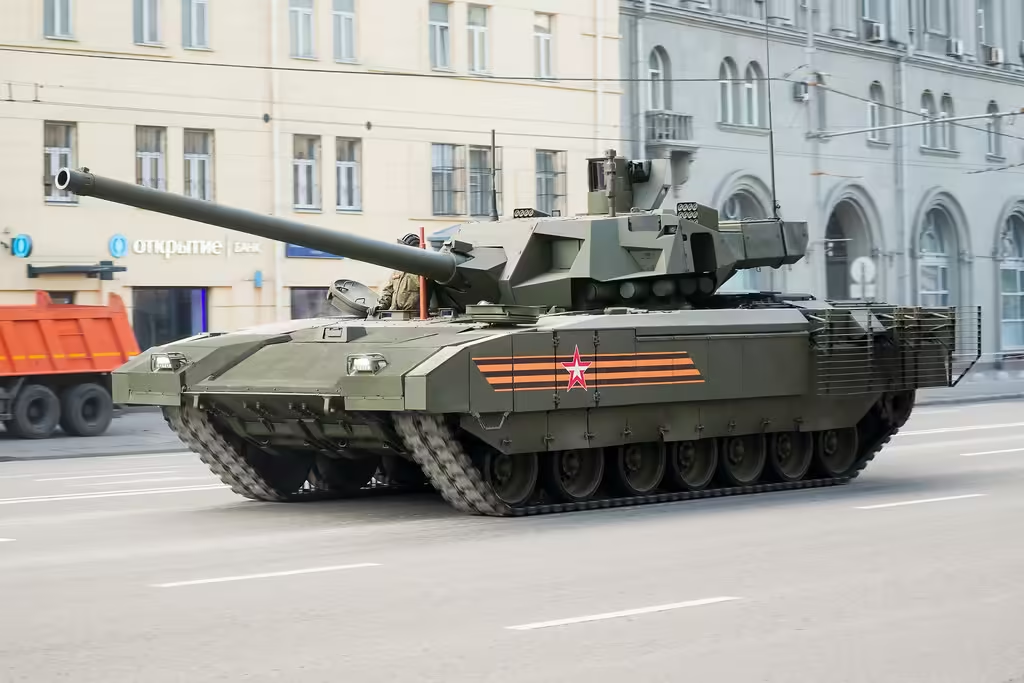
Table of Contents
Summary and Key Points: Russia’s Soviet-era main battle tanks, such as the T-55s, T-62s, T-72s, T-80s, and T-90s, have been decimated by Western-supplied anti-tank weaponry during the Ukraine invasion. The deployment of the latest T-14 Armata tanks was short-lived in Ukraine, with claims they were too valuable for continued use.

-Recent sources indicate that improved versions of the T-14 are being produced, despite Kremlin claims of dominance; However, these plans are in doubt due to international sanctions and economic sanctions.
The T-14, which debuted in 2015, has yet to prove to be a useful weapon in combat despite its advanced features such as an autonomous turret and superior survivability.
Russia’s T-14 Armata: The Tank That Failed to Make an Impact in Ukraine
On the front lines of the invasion of Ukraine, Russia’s main battle tank fleet has largely failed to gain momentum since the Soviet era.
Large tracts of T-55s, T-62s, T-72s, T-80s and T-90 tanks have been completely destroyed by Kiev’s anti-tank weaponry, supplied by the West, for over 2.5 years. Moscow had deployed the latest T-14 Armata tank series last year to try to compensate for its heavy MBT losses in combat.
Although the Kremlin boasts that the most recent MBT version is an invincible force capable of opposing its Western peers such as the British Challenger and the American-built Abrams, the Armata’s involvement in the conflict is brief. According to Russian state media channels, the Armata tanks were prematurely removed from the front lines, because they are “too valuable.” The CEO of the MBT’s manufacturer Rostec also reiterated that the T-14 is “much superior” to existing tanks.
Given the state of Russia’s rapidly dwindling MBT inventory, more T-14 class tanks may still be in use, if they are as reliable as the Kremlin would like to claim. A new article in the Bulgarian Military claims that Rostec is moving forward with integrating several changes to the Armata platform. According to the article, work is underway on an improved T-14 tank design that will include a more powerful 152-mm barrel and a stealthy turret that can fire rounds over a meter away:
“This includes powerful armor-piercing finned projectiles. A core length of 1024 mm, Manufactured by Rosatom, and an advanced high-explosive and thermobaric projectile with remote detonation.” The new 152 mm caliber BOPS is made of a strong, substantial material.materials, possibly including depleted uranium. Its effective range is around 5 km.”
Russia Freaked Out: Why the U.S. Navy ‘Unretired’ the Iowa-Class Battleships
The T-14 Challenge
But given Russia’s existing production and economic situation, these new and upgraded Armata ambitions seem vague at best. Extensive international sanctions imposed on Moscow since the start of the invasion in February 2022 have had a significant negative impact on the country’s economic growth.
In addition, over the past 2.5 years, the Kremlin has committed massive resources to the conflict and has been unable to continue producing more on all fronts.
It seems unlikely that Russia would commit its meager resources to building a new T-14 variant if the current model was deemed insufficiently “superior” to continue combat from earlier this spring.
A Brief Overview of the T-14 MBT:
Some of these prototype tanks were originally shown at Albino in 2015, marking the Armata’s official debut. The Russian Ministry of Defense formally unveiled the armada during the country’s annual Victory Day parade that year. It was created under the Object 197 program to replace the T-90 tank. The A-85-3A turbocharged diesel engine, which produces 1,200 horsepower, powers the new tank.
While the MBT may not be as strong as the Kremlin would like to think, the Armata has a wide variety of capabilities. An unmanned turret allows the crew to be housed in a fully protected compartment, which maintains a high tank level.
Furthermore, Armata can launch Vacuum-1 APFSDS projectiles and enhanced observation and fire control systems.

About the Author: Maya Carlin
Maya Carlin is a national security writer for The National Interest. She was previously an Anna Sobol Levy Fellow at IDC Herzliya in Israel and is an analyst at the Center for Security Policy. Her byline has been used by numerous publications such as The National Interest, The Jerusalem Post, and The Times of Israel.
READ | Poland’s Futuristic PL-01 Tank Cold Tank Design Futures


1 thought on “Russia’s T-14 Armata tank was forced to leave the Ukraine conflict.”